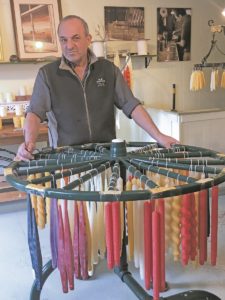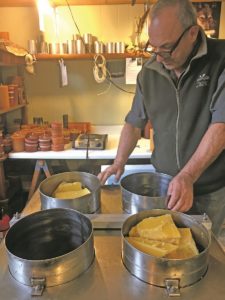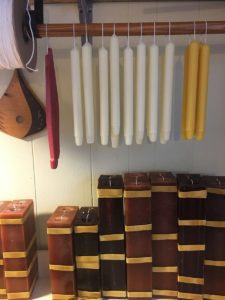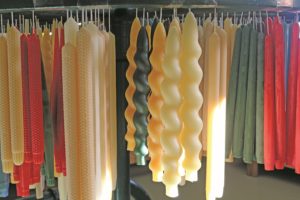The air in Agostino DiBari’s shop on Main Street in Orleans smells slightly sweet. But not in that Jolly Rancher way that can make scented candles so fearsome. It’s a smell that becalms. DiBari adds no perfumes to the natural beeswax he melts for candlemaking here.

Even though he’s been pouring pillars and dipping tapers at his Honey Candle Company for a quarter century, DiBari still speaks in the rhythms of Italy. He sidesteps a question about how he got from his hometown of Fasano, in Apulia, to Cape Cod. “There’s a saying where I come from,” he says. “ ‘You can know where you were born, but you will never know where you’re going to die.’
“I used to be a fisherman,” DiBari says. “I’m on the Cape because living far from the ocean is painful for me.” Finally, he admits, “There was a woman, of course.”
DiBari came to the U.S. in 1990 and took a job as an apprentice in a ceramics company. The clay was incidental, he said; what he loved was shaping the molds. The skills he once applied to tiles and plates were what he wanted to draw on when he decided to start a business of his own. “I had no idea about beeswax,” he says.

He makes his own molds — for twisted tapers, pine cones, towers, spirals, honeycomb-relief candlesticks, the Provincetown monument — all except the ones used for pouring perfectly smooth-sided simple pillars. Those, he says, are better made in commercial molds.
After building a prototype, he seals it in rubber. Once that sets, the mold can go into use. It’s the same principle as slipcasting, he explains, but there is no need to create a master mold and then make production molds from it.
“When I see something I like,” he says, “I make a mold.” He is inspired by nature, he says, but also by Baroque ornamentation. “I look at a 17th-century table leg, say, and I know it will make a good candle.

“In the beginning, I made a few candles from paraffin,” DiBari continues, “but once you work with wax you understand the difference.” Everything about beeswax is better, he says — the shrinkage, the dynamics, the “dense, gorgeous” way it takes on color.
DiBari says he uses liquid colors that pass muster in California, where Proposition 65 standards for exposure to harmful chemicals are strict. “Why would you want to contaminate good beeswax?” he asks. “I want the same colors they use for crayons for children.”
The wax DiBari uses comes from a North Carolina company that harvests it from apiaries along the East Coast. It’s then double filtered. Once, he says, he tried using home-filtered wax given to him by local beekeepers, but it couldn’t match the quality of what he’s able to buy. Particles of propolis, bits of bees, and pollen made it look murky in his vats and caused the wicks in finished candles to sputter out.

Normally, DiBari keeps about 100 pounds of wax melted to 160 degrees in his four vats. He makes everything, whether shaped by molds or dipped, on two workbenches behind the cash register. To get from now through the winter holidays, DiBari figures he’ll need about 1,500 pounds of wax. He’s awaiting an order of 1,200 pounds now, which should help him catch up. His stores dwindled during the pandemic because deliveries weren’t reliable.
He doesn’t have a favorite design. “If you have a beautiful pedestal for it, a simple two-inch-diameter pillar, 25 inches tall — that’s nice,” he says. “With beeswax, in the end, it’s not the shape of the candle, it’s the glow of the candle as it burns. It’s the only wax whose glow is similar to sunlight.”



